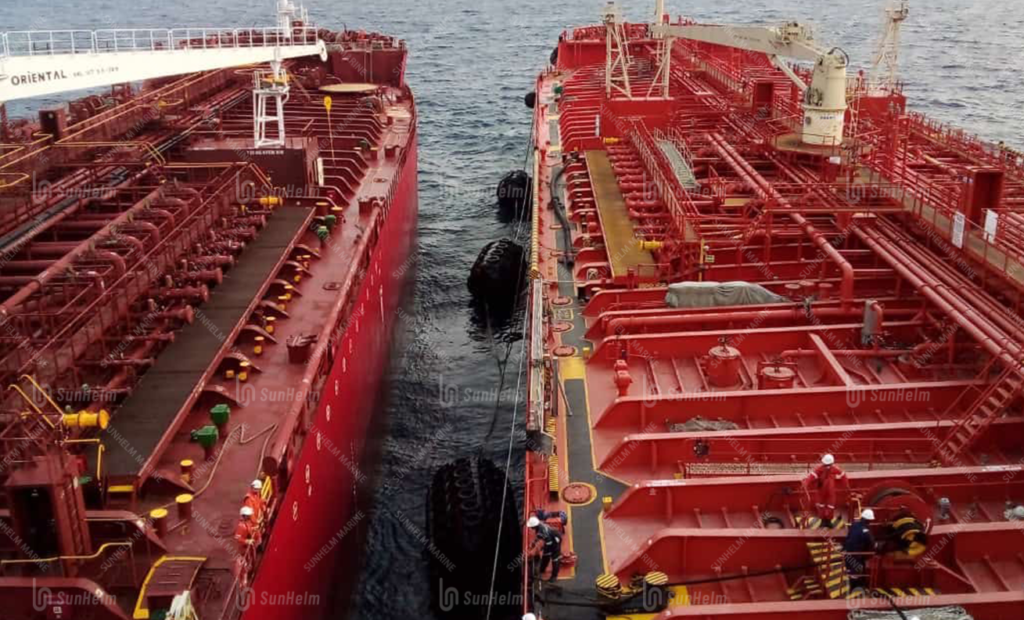Ship-to-ship (STS) transfer plays a key role in modern shipping. It involves moving cargo directly from one vessel to another while both ships stay side by side or close together. Shipping companies choose STS transfers because they want to save time, avoid port congestion, and handle large volumes efficiently. In this article, we will explain what cargo types operators usually transfer, how they manage safety, and what new trends are shaping this process.

1. Introduction to STS Transfer
Ship-to-ship transfer means moving cargo between two vessels at sea or at an anchorage. Operators choose STS operations when:
- Ports limit the size or draft of vessels.
- Large tankers cannot enter shallow harbors.
- Companies need to deliver cargo or fuel offshore.
- Owners want to reduce costs and avoid delays.
Consequently, STS transfers have become common in oil, gas, and chemical shipping, although operators also use them for other cargo types under strict safety rules.
2. Types of Cargo Suitable for STS Transfer
a) Crude Oil and Refined Petroleum Products
Oil companies frequently transfer crude oil and refined products offshore. For example, they often use lightering operations to move crude oil from very large crude carriers (VLCCs) to smaller tankers that can reach shallow ports. Typical products include:
- Crude oil
- Gasoline
- Diesel
- Jet fuel
- Low-sulfur fuel oil
Because oil is highly flammable and polluting, operators follow strict safety procedures. They install vapor recovery systems, ground the transfer hoses, and protect the ships with large pneumatic fenders.
b) Chemicals and Liquid Bulk Cargo
Chemical carriers also rely on STS transfers. They handle:
- Liquid chemicals like methanol, benzene, and caustic soda
- Vegetable oils and edible liquids
- Industrial bulk liquids
Before starting, operators always check cargo compatibility to avoid dangerous reactions. Moreover, they comply with MARPOL Annex II regulations to protect the environment.
c) Liquefied Gases: LNG and LPG
Operators increasingly transfer liquefied gases at sea.
- LNG (Liquefied Natural Gas): Crews use cryogenic hoses, insulated manifolds, and continuous temperature monitoring because LNG stays at −162 °C.
- LPG (Liquefied Petroleum Gas): They pump LPG under pressure and rely on gas detection systems to prevent leaks.
As global demand for natural gas rises, LNG STS transfers grow steadily. However, operators must always follow strict safety procedures to control risks.
d) Marine Fuel (Bunkering)
Bunkering, which means refueling a ship, is one of the most common STS operations. Smaller bunkering vessels deliver marine fuel directly to larger ships. With stricter emission rules in place, operators now handle:
- Low-sulfur fuel oil
- Marine gas oil (MGO)
- Alternative fuels such as methanol, ammonia, and biofuels
As a result, bunkering operations are evolving quickly, and ports have introduced tighter monitoring to ensure compliance.
e) Dry Bulk Cargo
Although dry bulk cargo rarely uses STS transfers in open seas, operators sometimes handle bulk products offshore, especially in sheltered waters. Common examples include:
- Coal
- Grain
- Iron ore
- Fertilizers
In these cases, companies often use floating cranes and barges to make the transfer safer and faster.
f) Containers and General Cargo
Transferring containers between ships is rare but possible. Offshore projects and transshipment hubs sometimes require operators to move containers directly from one vessel to another. Specialized cranes or floating terminals make these operations possible.
g) Emerging Cargo: Alternative Fuels
New fuels are reshaping the STS industry. For instance, in 2024, operators successfully transferred ammonia between two ships in Australia as part of a demonstration project. Similarly, methanol and biofuels are gaining attention. These fuels require strict handling procedures because they are toxic or highly flammable.
3. Safety and Equipment in STS Operations
STS operations involve risks such as fire, leaks, and environmental damage. Therefore, operators use advanced equipment and trained personnel to reduce these risks:
- Pneumatic fenders prevent hull damage during mooring.
- Transfer hoses or loading arms handle different pressures and temperatures.
- Gas detection systems monitor leaks, especially during LNG and LPG transfers.
- Emergency shutdown systems allow crews to stop pumping immediately.
- Reliable communication systems ensure constant coordination between both vessels.
4. Regulations and Guidelines
Operators must follow strict rules when performing STS operations:
- OCIMF STS Transfer Guide sets global standards for petroleum, chemical, and gas transfers.
- MARPOL Convention outlines international regulations to prevent marine pollution.
- Local port authorities often require operators to submit an STS plan, risk assessment, and emergency response strategy before starting.
By following these guidelines, companies reduce operational risks and avoid penalties.
5. Industry Trends
- Growing LNG and LPG transfers: More countries now rely on natural gas, so LNG STS activity keeps expanding.
- Alternative fuel bunkering: Ports like Singapore and Rotterdam have invested in ammonia and methanol transfer facilities.
- Digital monitoring: Operators increasingly use real-time sensors, automated logs, and AIS tracking to improve safety and transparency.
- Green transition: As the industry moves toward decarbonization, STS operations must adapt to handle cleaner fuels under stricter regulations.
6. FAQs
Q1: Can operators transfer any type of cargo offshore?
No. They only transfer cargoes that meet safety and environmental rules.
Q2: Do all STS operations require a plan?
Yes. Most ports and flag states require an approved STS plan and risk assessment.
Q3: Are STS transfers safe?
Yes, provided that crews follow industry guidelines and use proper equipment.
Q4: Can operators transfer LNG and ammonia at sea?
Yes, but only with specialized cryogenic equipment, strict monitoring, and trained personnel.


